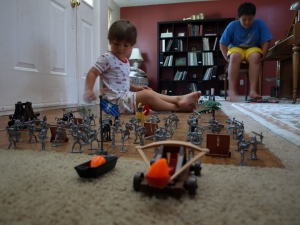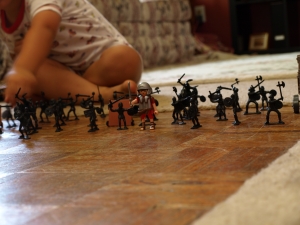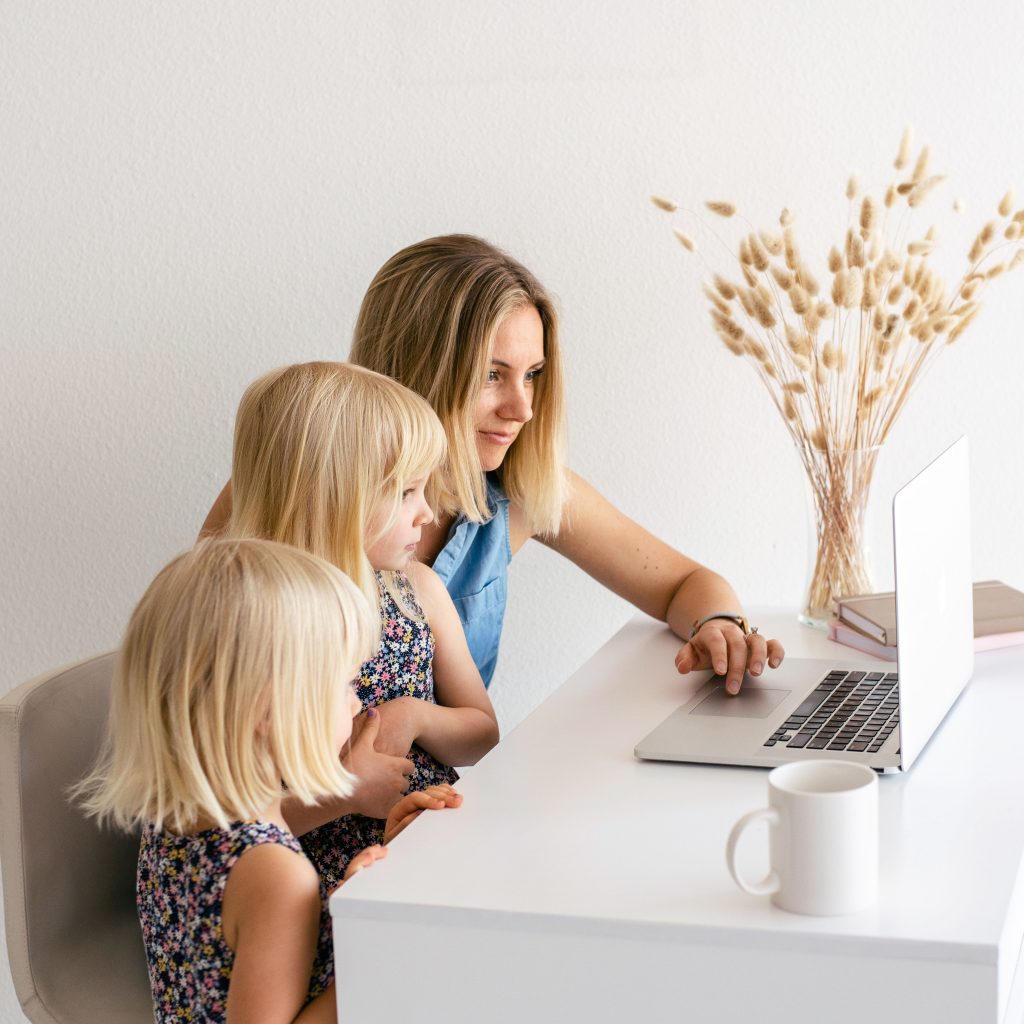Why preschoolers learn best with their siblings
 My three “school-aged” children have been studying the Middle Ages for the past several weeks. They have enjoyed tales of plundering barbarians who never take baths, conquering kings who unite peoples, and the development of their own English (or should we say “Anglish”?) language. We devoured Beowulf with a relish I never experienced in my own drab English Literature college course; the tale of a heroic young man who defends the honor of his father’s friend by slaying a dinosaur-like creature fired the imagination of us all.
My three “school-aged” children have been studying the Middle Ages for the past several weeks. They have enjoyed tales of plundering barbarians who never take baths, conquering kings who unite peoples, and the development of their own English (or should we say “Anglish”?) language. We devoured Beowulf with a relish I never experienced in my own drab English Literature college course; the tale of a heroic young man who defends the honor of his father’s friend by slaying a dinosaur-like creature fired the imagination of us all.
My 3-year-old has been the most fascinated by our studies. Indeed, he has been known to insult his sister with the epithet, “You look like Grendel’s mother this morning!” As I write this, he is barefoot in the backyard, waving a stick into the air, screaming to an imaginary king that he will, indeed, kill the “hideous monster Grendel, or die trying.” He must, for his father’s sake.
 Preschool-aged children benefit most educationally from exposure to their older siblings’ elementary and even secondary-level studies. By allowing our little ones to listen to the history lessons, observe the science projects, and watch the educational videos, we are exposing them to a broader world outside their own. Young children will learn and benefit in many ways by simply taking part in their brothers’ and sisters’ lessons.
Preschool-aged children benefit most educationally from exposure to their older siblings’ elementary and even secondary-level studies. By allowing our little ones to listen to the history lessons, observe the science projects, and watch the educational videos, we are exposing them to a broader world outside their own. Young children will learn and benefit in many ways by simply taking part in their brothers’ and sisters’ lessons.
Family Living: The Best Curriculum
There are many preschool curriculums out there. They are designed to enrich the early learner, to prepare him for reading, to begin his early logic and math reasoning, to expose him to his native environment and community, and to teach him biblical principles. These are all worthy ambitions and should even be a part of the home educator’s priorities. But a prepackaged preschool curriculum is not needed to achieve these goals. Simple family living—and particularly learning along with older siblings—is more than enough educational stimulation for the preschool-aged child.
There are several benefits to teaching the preschooler alongside his older siblings, rather than separately using a preschool curriculum. The most obvious is convenience. A busy mother does not need another lesson plan to write down, another teacher’s manual to juggle, and another subject to cram into an already busy and stimulating daily schedule. Including the youngest members of the family in Bible, history, science, literature, language, music, art, and other lessons and activities is so much easier than adding yet more.
Another benefit is the preschooler’s own educational and cultural enrichment by being exposed to challenging, yet interesting, material “above his grade level.” As the pre-reader listens to his parents and older siblings discuss history and classic literature, scientific theories and discoveries, and current events and worldview issues, his own horizons are opened. The young one sees by example that learning is fun, education is part of the family’s lifestyle, and there is wisdom to be found if he seeks it with his whole heart. The seeds are planted for a lifelong love of learning, right alongside the ones who love and know him best.
The stage is being set, as the child listens to read-alouds and book discussions, for his own reading education. Though most children don’t begin reading independently until sometime between ages 5 and 10, their attitude toward books and reading in general is molded from a much younger age. Creating a hunger for books and for the wealth of information inside them is an important motivational step in learning to read.
Though the preschool-aged child can’t be expected to understand concepts on the same level as his older siblings, he most definitely benefits from learning alongside them. His vocabulary broadens as he listens to their classic literature being read aloud. His love of words grows as he listens to them recite poetry and Bible verses, joining in on his own favorite lines. His world expands as he learns of other cultures and races. His imagination ignites when he observes science experiments or models. Exposure to a variety of historical, cultural, and literary people and places fires his imagination, fueling his desire to learn yet more so he can play with his new imaginary friends from the past.
Teaching the children together is not only good for little ones, but also for the family as a whole. Including preschoolers with the rest of the family in learning only increases family unity. Shared experiences around treasured books, ancient wonders, and science discoveries become family memories that last for years. Characters from books, people from history, and expressions from mythology will soon creep into shared conversations, making for a unique family language.
Read-Alouds, Unit Studies, and More
Practical Ways to Include Your Preschooler
There are many ways to easily and naturally include your younger children in family learning. The first—and perhaps most important—is to include little children in read-aloud time. Classic literature, retellings of history, and biographies of influential people are all healthy food for young minds. While toddlers or pre-readers may not sit still for extended periods of reading, they will be happy for quite some time if held on Mommy’s lap for part of the reading—longer if the book contains pictures. When the wiggles take over, the young one can play with quiet toys, puzzles, or coloring books while listening. To keep my young audience captivated, I read aloud during lunchtime. By the time hungry bellies are full of sandwiches and fruit, little ones are too sleepy to move from their chairs.
It is important to keep listeners of all ages engaged during family reading time. The more challenging the material, the more children must exert mental effort to retain the information. Keep young minds engaged by asking frequent questions throughout the reading: Where did we hear that name before? Who remembers when that battle took place? Why do you think she did that? Define difficult vocabulary as it is encountered, or ask a child to glean the meaning from the context. Encourage conversation around the book, even during the reading. It has sometimes taken us half an hour to read one page of interesting material, for all the conversation and backstory each child offered. Those sessions are not a waste of time; rather, they increase retention of the material.
Check out classic literature and history retellings from your library’s picture book section. Then allow siblings to read those light versions of the family read-aloud to the young one later in the day. Repetition aids learning, and meeting the same plot and characters later will make the work clearer to both the reader and the listener. Pictures and simple text will clarify the themes for the younger child too. Further, all the children may enjoy critiquing these classic retellings. When we read several picture books on Beowulf, my children were all disappointed that the hero’s motivation (his father’s honor) was left out or underplayed in all of them. They lost no time in emphasizing this important moral to their youngest brother when they read to him. Comparing pictures of Grendel made one son throw several books aside in disgust; few were hideous enough for him.
Unit studies lend themselves naturally to preschool inclusion. Projects, picture books, coloring pages, and dress-up times are even more fun with a pint-sized scholar adding his own unique interpretation. During notebooking or lapbooking times, the little ones will enjoy practicing cutting and pasting skills as well as coloring maps and art reproductions.
Math and logic studies are never neglected when a family learns together. Simply baking cookies with a young child is a huge lesson in counting (how many eggs? how many cookies on a sheet?), unit comparison and conversion (teaspoon, tablespoon, and cups), liquid volume (cups, quarts, gallons), measuring (carefully!), and time. Running errands and cleaning house provide ample opportunity to sort, compare, count, and divide. Siblings love playing games together, and whether they are counting spaces on a board or matching numbers on a card, there is always math involved.
Scripture memory is just as important for the young ones. As the family recites a passage or chapter together, small mouths will attempt to fill in a few words or phrases. Pre-readers seem to memorize quickly when chanting or repeating multiple times, so be sure to say the passage more than once in a sitting. In this manner, the young child will develop an ear for the cadence of well-placed words and a heart for the Word of God.
Educational outings are always beneficial and enjoyable for young learners. Museums and exhibits can be explained in simple terms. Encourage older siblings to share their knowledge of a display or art to increase the learning opportunities for everyone. (You can read more about including preschoolers in field trips in “We Know Because We’ve Been There: Taking Educational Outings with Little Ones” from Home School Enrichment Mar/Apr 2010.)
Today’s read-aloud included the story of William Tyndale and Henry VIII. Only the 3-year-old at the kitchen table realized that smuggling English Bibles into England involved a cops-and-robbers type scenario. This time, as he pointed out, the robbers were the “good guys.” He may not remember all the names and dates, but I think he got the point.
first published in Home School Enrichment magazine, Mar/Apr 2011

Thank you so much for this post. I will be embarking on the homeschool journey this year with my 5 year old and 1 year old. This is so encouraging to know that the best place for the baby will be to be right alongside us as we learn together. Your insight is invaluable to this first-time homeschooling mom!
Right on, Lea Ann! We’ve been reading about Catholics and Protestants in the context of continued European history, so I wasn’t too surprised when I overheard our littlest of 4 9/10 telling his older brother of 6 that during their chess game HE would be the Protestants!!! And earlier today, the 6 year old explained that his Playmobile figure was an Israelite. The littler brother wanted to know where he was headed and where from, putting older brother on the spot and taxing his memory. Taking the easiest route, bigger brother of 6 exclaimed at last: “He’s coming from Egypt of course!” That answer led to a discussion about the Jews and Israelites and the naming of peoples amongst the three of us, 4 9/10, 6, and Mama. Finally, little brother started taking notes at a lecture this Wednesday night something that his older brothers haven’t ever done. No matter that he was only writing numbers. He was so excited to be doing what bigger children do and mommy does and it kept him paying close attention throughout the entire 1 1/2 hour lecture on creationism science! Big brother of 10….Look out! These little ones just might beat you in the next game of Protestant/Catholic chess!!! (But only because you taught them to play so well!)
Frenchie,
{I must try to love you anyway}. This makes me laugh. The little ones DO really challenge their older siblings in this way. And the little guy’s growing certainty of his own learning can even further rattle the big-brothers’ confidence. I like it. Keeps them motivated. : )
This encourages for a number of reasons. I will skip the long story. Let’s just say there’s some first-born perfectionism in there. I have been contemplating how to approach this as we continue, and today’s post reminds me Meatball will be just fine if I just include him at the table more. 😉
I wasn’t always this relaxed, trust me, Jenny. It took me a while to learn to let the preschoolers be little. {poor Gian}.